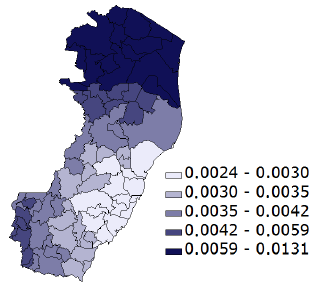Last week I attended SAS Global Forum 2016 in Las Vegas. I and more than 5,000 other attendees discussed and shared tips about data analysis and statistics.
Naturally, I attended many presentations that featured using SAS/IML software to implement advanced analytical algorithms. Several speakers showed impressive mastery of SAS/IML programming techniques. In all, almost 30 papers stated that they used SAS/IML for some or all of the computations.
Seven papers in advanced #analytics from SAS Global Forum 2016 #SASGF Click To TweetThe following presentations were especially impressive. As you can see, topics include Bayesian analysis, signal processing, spatial analysis, simulation, and logistic regression.
- Jason Bentley, a PhD student at The University of Sydney, presented a paper about Bayesian inference for complex hierarchical models with smoothing splines (joint work with Cathy Lee). Whereas Markov-chain Monte Carlo techniques are "computationally intensive, or even infeasible" for large hierarchical models, Bentley coded a "fast deterministic alternative to MCMC." His SAS/IML code runs in 22 seconds on a hierarchical model that includes 350 schools and approximately 88,000 students. Jason says that this was his first serious SAS/IML program, but that he found the language "ideal" for implementing the algorithm.
- Woranat Wongdhamma at Oklahoma State University used wavelet analysis in SAS/IML to construct a predictive model that helps clinical researchers diagnose obstructive sleep apnea. I did not realize that 1 in 15 adult Americans have moderate or severe sleep apnea, and many of these people are undiagnosed. Hopefully Wongdhamma's analysis will help expedite the diagnosis process.
-
 Alan Ricardo da Silva, a professor at the University of Brasilia, has written many papers that feature SAS/IML programs. This year (with T. Rodrigues), Alan showed how to implement an algorithm for geographically weighted negative binomial regression. He applied this spatial analysis method to freight transportation in Brazil. The image at right is taken from his paper.
Alan Ricardo da Silva, a professor at the University of Brasilia, has written many papers that feature SAS/IML programs. This year (with T. Rodrigues), Alan showed how to implement an algorithm for geographically weighted negative binomial regression. He applied this spatial analysis method to freight transportation in Brazil. The image at right is taken from his paper.
- A second paper by da Silva (with co-author Paulo da Silva) shows how to use SAS/IML to simulate data from a skew normal and a skew t distribution.
- Gongwei Chen used SAS/IML to build a discrete-time Markov chain model to forecast workloads at the Washington State Department of Corrections. Social workers and parole officers supervise convicted offenders who have been released from prison or were sentenced to supervision by the court system. Individuals who exhibit good behavior can transition from a highly supervised situation into less supervision. Other individuals might commit a new offense that requires an increase in supervision. Chen's probabilistic model helps the State of Washington forecast the resources needed for supervising offenders.
- Katherine Cai and Jeffrey Wilson at Arizona State University used SAS/IML to build a logistic model of longitudinal data with time-dependent covariates. The algorithm was applied to obesity data and to children’s health data in the Philippines.
- Another paper by Wilson (co-authored with Kyle Irimata) used SAS/IML to implement exact logistic regression for nested binary data.
The SAS/IML language was used in many other e-posters and presentations that unfortunately I could not attend due to other commitments. All of the papers for the proceedings are available online, so you can search the proceedings for "IML" or any other topic interests you.
Experienced SAS programmers recognize that when an analysis is not available in any SAS procedure, the SAS/IML language is often the best choice for implementing the analysis. These papers and my discussions with SAS customers indicate that the SAS/IML language is actively used for advanced analytical models that require simulation, optimization, and matrix computations. Because SAS/IML is part of the free SAS University Edition, which has been downloaded 500,000 times, I expect the number of SAS/IML users to continue to grow.
